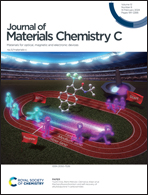A nanoflower-like GaSe/β-Ga2O3 based heterostructure for highly efficient self-powered broadband photodetectors†
Abstract
The rising demand for missile warnings, fire alarms, and astronomical imaging applications makes gallium oxide a promising ultra-wide band gap semiconducting material. Integrating gallium oxide with a suitable material can enhance the performance parameters of the device. An innovative integration approach provides an alternative method for creating a heterostructure without restricting atomic lattice mismatch. This report combines nanoflower-like GaSe with thermally annealed β-Ga2O3, forming a heterostructure that can efficiently detect in the deep ultraviolet (UV) to the visible region. The developed heterostructure exhibits self-powered photodetection with a high responsivity of 2200 mA W−1 in the deep UV spectral range (266 nm) and 1560 mA W−1 in the visible spectral range (625 nm), while in the photoconductive mode, the maximum responsivity is observed to be 2.4 × 105 mA W−1 @ 5 V, along with low noise equivalent power (10−13 W Hz−1/2) and very high external quantum efficiency (104%). This study opens possibilities for developing GaSe/β-Ga2O3-based devices with high responsivity, self-powered operation, and low bias broadband photodetectors with a simple architecture, excellent reliability, and easy processing for future optoelectronic devices.



 Please wait while we load your content...
Please wait while we load your content...